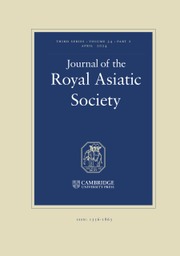No CrossRef data available.
Article contents
Art. V.—Description of an Execution at Canton
Published online by Cambridge University Press: 14 March 2011
Extract
The place used as the execution – ground at Canton is in the southern suburbs, about midway between the forts known to foreigners as the Dutch and French “Follies.” It is, however, some distance back from the river, being about halfway between the southern wall of the city, running parallel to the river, and the latter; distant from each 120 or 130 yards in a straight line. There is no street leading directly to it either from the river or the city. There is a dense population all around, composed, towards the north and west, of the inmates ef shops and dwellings, respectable in its immediate neighbourhood, and getting more wealthy as the foreign factories (distant about a mile) are approached. To the south and east the suburb is, generally speaking, poor, inhabited by low and even criminal classes. The execution-ground itself is a short thoroughfare or lane, running north and south, about fifty yards in length, eight yards in breadth at its northern end, and gradually narrowing to five yards at its southern extremity, where the projection of a house-corner reduces it to a mere passage of one yard and a half in width, and five in length. At the end of this latter is a high strong door, closed and guarded during executions. The eastern side of the ground is bounded in its whole length by a dead brick wall, of about twelve feet high, forming the back of some dwellings or small warehouses.
- Type
- Original Communications
- Information
- Copyright
- Copyright © The Royal Asiatic Society 1856
References
1 In the language of criminal procedure this word means “to punish;” in ordinary language its signification is “to do,” “to transact,” &c.


